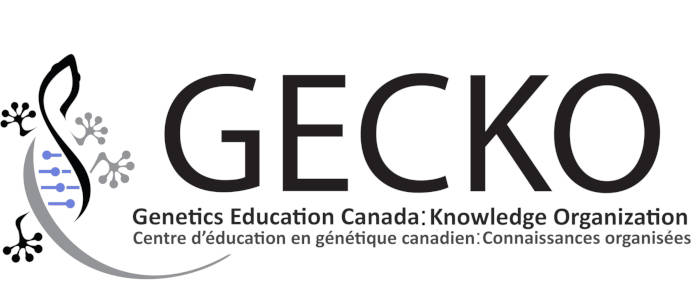
Download the comprehensive GECKO Deep dive, the quick reference GECKO on the run, and/or the point of care tools on who to offer genetic testing and surveillance and management.
Updated Nov 2025
| Bottom line: Hereditary Hemochromatosis (HH) is a common inherited iron overload disorder. Affected individuals are predisposed to absorb excess iron from their diet due to improper regulation of iron homeostasis. Over time excess iron can be deposited in organs leading to dysfunction. The most common type is caused by pathogenic variants in the HFE gene. Homozygosity (two copies) of the C282Y variant in this gene is associated with highest risk for iron overload. HFE-related HH is an autosomal recessive condition where one must inherit two pathogenic variants (one from each parent) to be at risk for iron overload. Most individuals with this predisposition never develop clinical disease. While HH does have the potential to cause morbidity and mortality, with early identification of at-risk individuals, appropriate surveillance of iron indices, and treatment (phlebotomy) when necessary, many complications can be avoided.
Genetic testing for HH should be considered for adult individuals with:
|
Jump to a section
- What is Hereditary Hemochromatosis?
- What do I need to know about the genetics of HH?
- Who should be offered genetic testing?
- What does the genetic test result mean?
- How do I order the genetic test?
- Where do I refer my patient?
- Are there benefits or considerations of genetic testing?
- Surveillance and Management
- References
- Resources for the public
What is Hereditary Hemochromatosis?
Hereditary Hemochromatosis (HH) can be caused by harmful changes (pathogenic variants) in different genes. Pathogenic variants in the HFE gene are the most common cause of adult-onset iron overload.1,2,3 This GECKO Deep dive deals EXCLUSIVELY with HFE-associated HH.
Pathogenic variants in the HFE gene alter the regulation of iron absorption through the mucosal lining of the gastrointestinal tract. In some predisposed individuals, excessive iron absorption and subsequent storage in various organs (Table 1) eventually lead to cellular injury. If untreated, over time this can cause irreversible damage and shorten life expectancy. With early identification of at-risk individuals, proper surveillance of iron indices, and treatment when necessary, many complications can be avoided.3
While any of these health concerns can be caused by HH, the initial presentation of the condition may be non-specific and can include features such as fatigue and lethargy. The presence of two or more should greatly increase suspicion that the condition is present.
Table 1. Organs at risk of damage due to excessive iron storage4.
|
Organ |
Damage |
|
Liver |
Hepatomegaly, cirrhosis, primary liver cancer (hepatocellular carcinoma, cholangiocarcinoma) |
|
Pancreas |
Diabetes mellitus |
|
Heart |
Dilated cardiomyopathy, congestive heart failure +/- arrhythmia |
|
Joints |
Arthritis, especially metacarpophalangeal joints, hips, knees |
|
Skin |
Progressive hyperpigmentation |
|
Testes |
Hypogonadism, decreased libido and impotence in males |
Additional clinical manifestations of advanced iron overload:5
- Weakness, chronic fatigue
- Abdominal pain, weight loss
What do I need to know about the genetics of HH?
Inherited HH is most commonly caused by pathogenic variants in the HFE gene on chromosome 6.
An individual is at risk for HH when they have inherited two pathogenic variants in the HFE gene (one from each parent). There are common variants known to be present in individuals who are of northern European ethnicity named, C282Y and H63D. Homozygosity for the C282Y variant (having two copies of the C282Y variant, one inherited from each parent) causes 95% of HH.5 About 1 in 150 individuals of northern European ethnicity are affected by HH.5
Pattern of inheritance
Autosomal recessive
- An individual who has inherited two pathogenic variants in the HFE gene, one from each parent, has the predisposition to develop iron overload.
- A person with a single pathogenic variant is called a ‘carrier’ and is not at risk of iron overload.
How common is HFE-HH?
About 1 in 3 individuals of northern European ancestry are carriers (heterozygotes) of either the C282Y or H63D pathogenic variants.4, 5 About 1 in 150 individuals have two copies of (are homozygous for) the C282Y pathogenic variant (genotype C282Y/C282Y).3,5 The prevalence of HFE-HH in other ethnicities is lower.
Who should be offered genetic testing?
Standard testing by molecular genetics laboratories is targeted analysis to look specifically for the two most common HFE pathogenic variants named C282Y and H63D. Some laboratories may also test for a rare HFE gene variant called S65C.6 Multigene panel testing may be considered when an individual is not of northern European ethnicity.4
Genetic testing for HH should be considered for adult individuals with:4,5
- a positive family history even in the absence of symptoms
- elevated serum transferrin saturation, ferritin levels, or aminotransferase levels (ALT) in the absence of symptoms
- Transferrin saturation (TS) >45% and serum ferritin (SF) >300mg/L in men and post-menopausal women or >200mg/L in pre-menopausal women
- Elevation of ferritin alone is not necessarily due to iron overload. Ferritin is an acute phase reactant and secondary causes of increased levels may be infection, chronic liver disease, iron-loading anemia, chronic inflammatory state, malignancy.
- Individuals with HFE-HH occasionally demonstrate a normal TS and an elevated ferritin. If clinical suspicion is high and/or the patient has a family history of HFE-HH, genetic testing is still warranted.
- ALT can be elevated in up to 14% of the general population. If ALT is elevated, consider ordering SF and TS and if those are also elevated then consider genetic testing.
- the presence of symptoms, especially two or more, particularly liver disease or arthritis
- mean red-cell volume >94 fl
Symptoms of HH: 4,5
- Weakness, chronic fatigue
- Abdominal pain, weight loss
- Arthropathy (especially metacarpophalangeal joints, hips, knees)
- Diabetes
- Hepatomegaly
- Cirrhosis
- Primary liver cancer (hepatocellular carcinoma, cholangiocarcinoma)
- Hypogonadotropic hypogonadism (decreased libido and impotence in males, amenorrhea in females)
- Cardiomyopathy, arrhythmias
- Progressive increase in skin pigmentation
Who should not be offered genetic testing?
Population screening for HFE-HH is not recommended as the disease penetrance is low.1,2,5,8
Children do not require genetic testing for HFE-HH. Please refer to the Canadian Paediatric Society Bioethics Committee policy statement that recommends against genetic testing for genetic conditions that usually manifest in adulthood. Predictive or susceptibility genetic testing should be postponed until a child is capable of making an informed decision about undergoing testing.8
What does the genetic test result mean?
If an individual is found to have inherited only one HFE pathogenic variant, they are a carrier and are not expected to develop iron overload. Adult relatives can be offered genetic testing to know if they also carry an HFE pathogenic variant and possibly a second variant and be at risk for HH.
The actual risk to develop iron overload is dependent upon which pathogenic variants are present, in addition to other genetic and non-genetic factors. Individuals who are homozygous for the C282Y variant (C282Y/C282Y) have about a 38-50% risk to develop iron overload and about 10-33% may develop iron overload-related symptoms.4 Many individuals never accumulate enough iron to cause disease.4 Individuals with a C282Y and a H63D pathogenic (C282Y/H63D) variants have about a 2% chance developing iron overload. Those who are homozygous for the H63D variant (H63D/H63D) have about a 1% chance of developing iron overload.
If no pathogenic variants are identified
- If an individual was tested because of a known family variant, they no longer need frequent monitoring of iron indices and are not at increased risk to develop iron overload. The test has ruled out HH.
- If an individual was tested because of a reported positive family history, more information is needed before ruling out HH in this individual. Your patient should be encouraged to obtain confirmation of the familial variants and/or diagnosis.
- If an individual was tested because of persistently high iron indices, additional investigations may be considered. Consider consulting a specialist e.g. hematology, internal medicine, or gastroenterology for next steps.
Other considerations:
- Women are less likely to develop iron overload as a result of menstruation and pregnancy1,2,3
- Iron overload due to HFEpathogenic variants does not occur in childhood1,2,3
- Typically, symptoms of HH present in men aged 40 to 60 and in post-menopausal women; however, onset is variable and can occur much earlier or much later3
- Early symptoms are nonspecific and include weakness, lethargy, joint pain and/or stiffness, and abdominal pain with or without hepatomegaly3
- Before the onset of symptoms, biochemical evidence of iron overload will be present: >45% transferrin saturation (TS) and >300mµ/L serum ferritin (SF) in men and post-menopausal women, or >200mµ/L SF in pre-menopausal women 1,2,3
- Alcohol consumption can exacerbate iron overload and HH- related liver disease3
How do I order the genetic test?
Genetic testing for HH is performed in a specialized hospital laboratory (molecular) on a blood sample. The blood sample can be obtained at any community lab. Click here to find your closest molecular genetics laboratory and the requisition to order testing. Some laboratories prefer that you attach their requisition to the Provincial Ministry of Health requisition. This process will expedite and simplify genetic testing when blood is drawn at a community laboratory.
It is important to include the following information on any requisition for the best test interpretation:
- Indication for testing e.g. ‘symptoms of indicated disease’ or ‘abnormal iron indices’ or ‘positive family history’
- Ethnicity e.g. Northern European
- Relevant family history e.g. parent/sibling with HH (include genetic test results of affected individual if known)
- Relevant medical history/investigations; e.g. biochemical iron overload
Where do I refer my patient?
Across Canada many Genetics clinics will no longer see individuals for the indication of HFE-related HH. Check your local genetics clinic for their referral criteria here. You may consider referral to a specialist e.g. haematologist or gastroenterologist for evaluation and initiation of treatment.
Are there benefits or considerations of genetic testing?
If pathogenic variants are identified
- Appropriate surveillance and management of the risk of iron overload can be initiated
If no pathogenic variants are identified
- If an individual was tested because of a known family variant, they no longer need frequent monitoring of iron indices and are not at increased risk to develop iron overload. The test has ruled out HH.
Targeted analysis
- Typically, only the C282Y and H63D variants are tested, not any HFE gene variant. However, the most common pathogenic variants account for more than 90% of all variants, thus fewer than 10% will be missed using current testing strategies.
Insurance discrimination
- In Canada, the Genetic Non-Discrimination Act (GNA) became law in 2017. This law protects Canadians and their genomic information. Some key points of the law are that GNA prohibits:
- Discrimination based on genomic characteristics
- Providers of goods and services (including insurance) from:
- requesting or requiring a genomic test
- requesting or requiring the disclosure of genomic test results either past or future
- Federally regulated employers from using genomic test results in decisions about hiring, firing, job assignments, or promotions
Surveillance and Management
Homozygosity for the C282Y pathogenetic variant is associated with complications in up to 40% of men and 13% of women.5 Symptoms are nonspecific and can be observed among those with and those without HH.5
Individuals with positive genetic testing and/or family history and are asymptomatic5
Transferrin saturation and ferritin levels should be measured in these individuals and if elevated further workup should proceed as outlined below (i.e. transferrin saturation (>45%) AND serum ferritin are elevated (>300mg/L in men and post-menopausal women; >200mg/L in pre-menopausal women). Homozygous individuals (C282Y/C282Y) with a normal serum ferritin at diagnosis are unlikely to develop significant iron overload later in life. Ongoing monitoring with periodic checks of liver aminotransferase is generally sufficient.9
Liver5
The most frequent clinical manifestations are liver disease (advanced liver fibrosis or cirrhosis and primary liver cancer) and arthritis. Liver fibrosis occurs in about 8% of women and 25% of men with hemochromatosis.5 Risk factors include heavy alcohol use, the presence of diabetes mellitus or arthritis, serum ferritin concentrations above 1000 µg/L, platelet counts below 200 × 10⁹/L, increased aspartate aminotransferase (ALT) levels, hepatic iron concentrations exceeding 200 µmol/g, and total mobilizable iron stores from therapeutic phlebotomy greater than 9.6g. Men who are homozygous for the C282Y variant have a 12-fold increase for liver cancer than men who do not. Homozygous women are not known to have an increased risk for liver cancer.
Individuals with advanced liver fibrosis should undergo routine liver ultrasonography cancer surveillance at 6-month intervals.
Arthritis5
HH-related arthritis affects at least 24% of individuals and is a major cause of disability and reduced quality of life. Arthritis may occur at any point during the natural history of hemochromatosis, even after successful therapeutic phlebotomy. Risk factors for arthritis include older age, advanced liver fibrosis, serum ferritin concentrations above 1000 µg/L, and serum transferrin saturation greater than 50% sustained for at least six years.
Treatment
Therapeutic phlebotomy, which is both safe and effective, is the mainstay of treatment for iron overload. With treatment many complications can be avoided.3 Treatment is usually indicated in the presence of biochemical evidence of iron overload (i.e. transferrin saturation (>45%) AND serum ferritin are elevated (>300 ug/L in men and post-menopausal women; >200 mg/L in pre-menopausal women), clinical manifestations, end-organ damage, and/or a SF of 1000 mg/L or greater.1,2,4 A genetic predisposition to iron overload (e.g. C282Y/C282Y genotype) is not on its own an indication for treatment in the absence of abnormal iron indices.
After initial treatment, maintenance therapy is performed to keep serum ferritin levels within the target range. Hemoglobin is also monitored. In most cases, this involves phlebotomy approximately every three months; however, the frequency varies widely and should be tailored to each patient’s individual needs.5
Individuals should also be advised to avoid consuming raw seafood to minimize the risk of Vibrio vulnificus infection (a bacteria that thrives on iron), to limit alcohol intake to lower the likelihood of developing advanced liver fibrosis, to avoid cast iron cooking utensils and vitamin C supplements. Dietary iron modification does not significantly alter SF levels and is not a substitute treatment for individuals with iron overload.1,2,4,5 Individuals with two HFE gene pathogenic variants should consider the hepatitis A&B vaccines.4
References
- Bacon BR, Adams PC, Kowdley KV, Powell LW, Tavill AS. Diagnosis and management of hemochromatosis: 2011 practice guideline by the American Association for the Study of Liver Diseases. Hepatology. 2011. 54:328–343.
- European Association for the Study of the Liver. EASL clinical practice guidelines for HFE hemochromatosis. J Hepatol. 2010. 53:3–22.
- Pilling LC, Tamosauskaite J, Jones G, Wood AR, Jones L, Kuo C, et al. Common conditions associated with hereditary haemochromatosis genetics variants: cohort study in UK Biobank. BMJ. 2019. 364:k5222.
- Barton JC, Parker CJ. HFE-Related Hemochromatosis. 2000 Apr 3 [Updated 2024 Apr 11]. In: Adam MP, Feldman J, Mirzaa GM, et al., editors. GeneReviews® [Internet]. Seattle (WA): University of Washington, Seattle; 1993-2025. Available from: https://www.ncbi.nlm.nih.gov/books/NBK1440/ [Accessed Nov 2025]
- Olynyk JK, Ramm GA. Hemochromatosis. N Engl J Med. 2022 Dec 8;387(23):2159-2170
- Wallace DF, Walker AP, Pietrangelo A, Clare M, Bomford AB, Dixon JL, et al. Frequency of the S65C mutation of HFE and iron overload in 309 subjects heterozygous for C282Y. J Hepatol. 36(4):474-479.
- Porto G, Brissot P, Swinkels DW, Zoller H, Kamarainen O, Patton S, et al. EQMN best practice guidelines for the molecular genetic diagnosis of hereditary hemochromatosis (HH). Eur J Med Genet. 2016. 24:479-495.
- Moore AM, Richer J; Canadian Paediatric Society, Bioethics Committee. Genetic testing and screening in children. Paediatr Child Health 2022 27(4):243–247. https://cps.ca/en/documents/position/genetic-testing [Accessed Nov 2025].
- Kowdley KV, Brown KE, Ahn J, Sundaram V. ACG Clinical Guideline: Hereditary Hemochromatosis. Am J Gastroenterol. 2019 Aug;114(8):1202-1218. Erratum in: Am J Gastroenterol. 2019 Dec;114(12):1927
Resources for the public
Canadian Hemochromatosis Society. Established to create awareness about the disorder. Additionally provides information and support. www.toomuchiron.ca [Accessed Nov 2025].
Authors: S Morrison MS CGC, JE Allanson MD FRCPC, S Walji MD CCFP and JC Carroll MD CCFP
Disclaimer:
· GECKO is an independent not-for-profit program that does not accept support from commercial or non-academic entities.
· GECKO aims to aid the practicing non-genetics clinician by providing informed resources regarding genetic/genomic conditions, services and technologies that have been developed in a rigorous and evidence-based manner with periodic updating. The content on the GECKO site is for educational purposes only. No resource should be used as a substitute for clinical judgement. GECKO assumes no responsibility or liability resulting from the use of information contained herein.
· All clinicians using this site are encouraged to consult local genetics clinics, medical geneticists, or specialists for clarification of questions that arise relating to specific patient problems.
· All patients should seek the advice of their own physician or other qualified clinician regarding any medical questions or conditions.
· External links are selected and reviewed at the time a page is published. However, GECKO is not responsible for the content of external websites. The inclusion of a link to an external website from GECKO should not be understood to be an endorsement of that website or the site’s owners (or their products/services).
· We strive to provide accurate, timely, unbiased, and up-to-date information on this site, and make every attempt to ensure the integrity of the site. However, it is possible that the information contained here may contain inaccuracies or errors for which neither GECKO nor its funding agencies assume responsibility.


